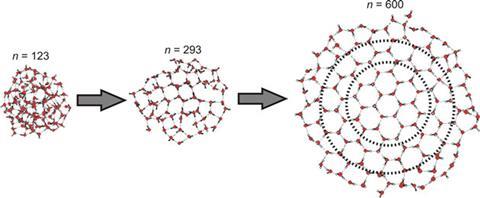
Ice crystals must contain at least 275 water molecules, say German chemists. This size limit has implications for any process that involves ice particles, from cloud formation to making the perfect gin and tonic.
To determine the smallest possible ice crystal, the German chemists, jointly led by Thomas Zeuch at the University of Göttingen and Udo Buck at the Max Planck Institute for Dynamics and Self-Organization in Göttingen, analysed various different size water clusters using mass spectrometry and infrared (IR) spectroscopy. They used mass spectrometry to determine the number of water molecules in each cluster, which ranged from 85 to 475, and IR spectroscopy to determine the structure of the water clusters.
Previous groups have struggled to perform both mass spectrometry and IR spectroscopy on such small clusters of water molecules. Zeuch and Buck managed it by doping the surface of the clusters with sodium atoms. These helped to ionise the water clusters for analysis by mass spectrometry, but because they were only present on the surface they didn’t alter the structure of the clusters, which could still be probed by IR spectroscopy.
IR spectroscopy records the specific IR frequencies absorbed by the chemical bonds in a molecule: the bonds in liquid water absorb at one frequency, while those in ice absorb at a slightly different one. So Zeuch and Buck simply looked for the smallest cluster that absorbed at the IR frequency characteristic of ice, finding the first evidence of ice-like absorption for clusters containing 275 molecules. This represents the start of the crystallisation process, which is more or less complete by the time you reach clusters with 475 water molecules.
‘We have determined the onset of crystallisation, which is the size where the inner core of the cluster becomes crystalline,’ explains Zeuch. ‘This is around 275 molecules. [By] adding more molecules the crystalline part of the cluster grows. For around 475 molecules, the cluster has become a nanocrystal showing the spectral features of ice. Thus, we have obtained a fully size-resolved picture of the gradual change between amorphous and crystalline ice.’
Smaller clusters are unable to crystallise into ice because there is simply not enough room for their water molecules to adopt the ice configuration, which is based around a central ring of six hydrogen-bonded water molecules. ‘The hexagonal ice crystal needs, because of the underlying hydrogen bonds, a lot of space and, therefore, a minimum number of molecules is required to form it,’ Zeuch tells Chemistry World.
‘This study is of major scientific importance, but it’s also a significant development from an experimental point of view,’ says Christoph Salzmann, a physical chemist who studies crystalline materials, such as ice, at University College London. ‘The experiments the authors have done are not easy; it’s a real achievement.’
Zeuch and Buck say that the same approach could be used to investigate the crystallisation process in other substances, such as alcohols. All of which bodes well for making the perfect gin and tonic.






No comments yet